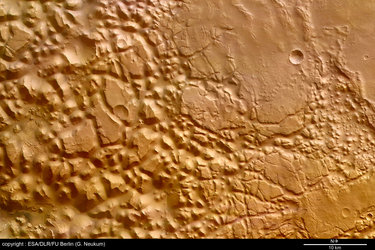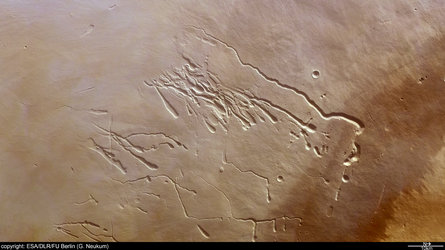Cydonia's 'Face on Mars' in 3D animation
Recently, ESA's Mars Express delivered photos of the famous 'Face on Mars' in the Cydonia region. The High Resolution Stereo Camera images are some of the most spectacular views of the Red Planet ever taken. Now, there's a stunning 3D animation of the area.
The High Resolution Stereo Camera (HRSC) science team have produced a dramatic 3D animation that beautifully simulates a flight over the Cydonia 'Face on Mars', one of the most famous surface features on the planet.
The movie sequence was produced through a combination of digital data from the HRSC and the Mars Orbiter Camera (MOC) on board NASA's Mars Global Surveyor, in a technique similar to that used to create the Cydonia 'Face' 3D still images published on the ESA portal in September. The 3D animation starts looking towards the East, and finishes with a still image looking South.
The Cydonia region lies at approximately 40.75° North and 350.54° East, and is located in the Arabia Terra region on Mars, in the transition zone between the Southern Highlands and the planet's northern plains.
The famous 'face' - actually a remnant massif - was first observed in a photo taken on 25 July 1976 by the American Viking 1 orbiter. Shortly afterwards, a NASA press release said the formation "resembles a human head." At the time, NASA scientists had already correctly interpreted the image as an optical illusion caused by the illumination angle of the Sun, the formation's surface morphology and the resulting shadows, giving the impression of eyes, nose and mouth. The new HRSC images confirm again the natural origin of this geological feature.
Note to editors
The HRSC science team is led by Principal Investigator Prof. Dr Gerhard Neukum. The team consists of 45 co-investigators from 32 institutions and 10 nations. The systematic processing of the HRSC image data is carried out by the German Aerospace Centre (DLR), while the images shown here were processed by the PI group at the Institute for Geosciences, Freie Universitaet (Free University), Berlin, in cooperation with DLR's Institute of Planetary Research, Berlin.
For more information
Agustin Chicarro, ESA Mars Express Project Scientist, The Netherlands
Email: agustin.chicarro @ esa.int
Gerhard Neukum, HRSC Principal Investigator, Freie Universitaet, Berlin, Germany
Email: gneukum @ zedat.fu-berlin.de















 Germany
Germany
 Austria
Austria
 Belgium
Belgium
 Denmark
Denmark
 Spain
Spain
 Estonia
Estonia
 Finland
Finland
 France
France
 Greece
Greece
 Hungary
Hungary
 Ireland
Ireland
 Italy
Italy
 Luxembourg
Luxembourg
 Norway
Norway
 The Netherlands
The Netherlands
 Poland
Poland
 Portugal
Portugal
 Czechia
Czechia
 Romania
Romania
 United Kingdom
United Kingdom
 Slovenia
Slovenia
 Sweden
Sweden
 Switzerland
Switzerland






































